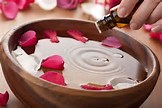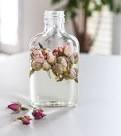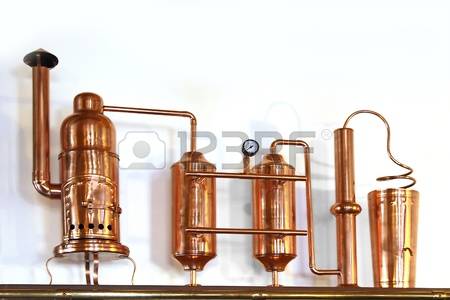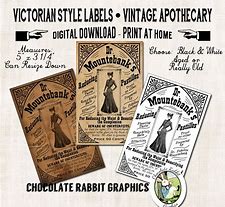Shelf Life and Marketing - Hydrosols








Shelf Life and Marketing - Hydrosols
Most products have a shelf life, and certainly all natural products, particularly those without added preservatives, have a shelf life - usually a short one at that. Why, even Budweiser beer, which is preservative free, has a shelf life of only 110 days. Why is it? then, so difficult for us to understand that hydrosols are the same? Perhaps it is because we are so spoiled by the longevity of most essential oils, which can have a long or even indefinite life span. Many improve with age like fine wine. Is this what has skewed our expectations of hydrosols?
yet many aromatherapy exams include specific questions regarding the citrus and conifer oils because they have a relatively short shelf-life.
It is considered good training to be aware of this and know how to deal with it. Oxidation of these monoterpene-rich oils can happen any time, and if it does, the oil is usually thrown away or used for household cleaning because of the increased dermocausticity.
Shelf life is a fact of life. many of the carrier oils used in aromatherapy have short shelf lives; rose hip seed, avocado, hazelnut, macadamia, borage, evening primrose - the list is endless.
Even long-life carrier oils like, sesame, olive, and real sweet almond oil will go off eventually. So, although hydrosols do have a short life, many of the products we incorporate into our aromatherapy practice actually have shorter lives.
Perhaps our fears should be place in perspective, where we can see that they are born mostly out of lack of knowledge and information and are not the final word on these wonderful products.
Reference: Hydrosols The Next aromatherapy: Suzanne Catty
Storage after Packaging










Storage after Packaging
Storage of hydrosols after sterile bottling should be the same as for bulk storage: a cool or cold and constant temperature, away from heat and light.
Treat hydrosols like you would milk or a bottle of mineral water. If you drink half a bottle of mineral water and leave it in the car for two weeks, do you want to drink it again? It's just common sense.
Treat hydrosols with a little respect and they will stay fresh for at least eight months and for up to two years or more from day of distillation.
Reference: Hydrosols The next aromatherapy: Suzanne Catty
No Added Preservatives







No Added Preservatives
In my definition of hydrosols, I state that they must not contain additives or preservatives. This is a purist's definition; ultimately it is a matter of personal choice. If you do forego preservatives, the information about pH will help you monitor your unpreserved waters. Ethyl alcohol, a good sterilization medium, can be used also as a preservative, as it is in commercially available witch hazel, which is actually a hydrosol.
Hamamelis virginiana is distilled only for its aromatic water, and this is the true witch hazel. However, the witch hazel you buy contains no less than 1 percent and up to 30 percent alcohol by volume. Witch hazel hydrosol is only moderately stable, and as it is sold in huge quantities in so many outlets, something must be done to stabilize the product. Since witch hazel is often used as a "sports rub," adding ethyl alcohol to it is not considered a problem.
However, as you will read under the profile of Hamamelis, there is much that it is good for, and many of these properties, such as its beneficial effect on varicose veins, are diminished by the addition of alcohol. Another preservative being explored is grapefruit-seed extract. This natural compound has antioxidant properties and some bacterisidal effects. However, it makes many hydrosols foamy, changes the pH, and is highly bitter, so only the debittered variety is appropriate for our purposes.
If you are using hydrosols only topically, the bitterness is less of an issue, but I don't know anyone who doesn't want to drink rosewater or neroli or chamomile or bay or.....There is also the issue of organics with grapefruit seed. Citrus fruit is heavily sprayed with chemicals from flowering to maturation. It is difficult to believe that none of these chemicals are found in the seed. Although I'm not in favour of its use at all, anyone seriously wishing to pursue this option should look for both debittered and organic grapefruit-seed extract.
After alcohol, chemicals are the most commonly used preservative. If I was asked to choose, I would take the alcohol over chemicals any day. However, in the cosmetics industry, where many products contain hydrolates, chemicals are the standard procedure. Products made with preservative-free hydrosols do have a much shorter life, and this would not be acceptable for a large commercial company.
Reference:Hydrosols-he next Aromatherapy: Suzanne Catty
Proper Labelling-Cosmetics
Proper Labelling-Cosmetics
Labels are applied immediately, or even before bottling, as it is impossible to differentiate between a hundred blue bottles without removing the lids. The beauty of spray bottles is that once on, the lid never needs to be removed. From the day of bottling to the day the bottle is empty, you can disperse your hydrosol without risking contamination through frequent opening and closing of the container.
Even when bottles are labelled STERILE CONTAINERS, DO NOT OPEN, I watch people walk over, unscrew the lid, and hold the bottle to their nose. I know they just ain't help it, but really.....
If you buy hydrosols to resell, you should include the distillation date, the expiration or best-before-date, or both on your labels. You should also include the plant's country of origin as well as common and Latin names. The labelling requirements for hydrosols should be no less than those for oils.
Reference: Hydrosols, The Next Aromatherapy: Suzanne Catty
Articles - Most Read
- Home
- What are Hydrosols
- What are Hydrosols-2
- The Monographs
- How to Make a Hydrosol
- Table of Common Latin Names and pH Values - F - O
- Distilled or Extracted Specifically For Therapeutic Use - 3
- Kurt Schnaubelt
- What isn't a Hydrosol?
- Table of Common Latin Names and pH Values - P - S
- Wholly Water!
- Blue Babies
- Supply and Demands
- Mature Skin
- Recipes Alpha F
- Hydrosols In The Marketplace
- Chemicals: Friends or Foes?
- Hemorrhoids
- Water as Medicine
- Nelly GrosJean
- The Educated Consumer
- Genitically Modified Plants
- Influences
- Water Quality
Articles-latest
- Daucus carota/Wild Carrot Seed - pH 3.8-4.0
- Cupressus sempervirens/ Cypress-pH3.5-3.7
- Coriandrum sativum/Coriander Herb-and-Seed
- Comptonia peregrinal/Sweet Fern- pH 3.8
- Citrus clementine (fe) Clementine Petitgrain- pH 4.3-4.4
- Citrus aurantium var. amara (flos) /Neroli Orange Blossom-pH3.8-4.5
- Cistus ladaniferus/Rock Rose-pH 2.9-3.1
- Cinnamomum zeylanicum (ec) Cinnamon Bark-pH3.3
- Chamaemelum nobile/Roman Chamomile - pH 3.0-3,3
- Centaurea cyanus/Cornflower/Bachelor's Button-pH 4.7-5.0
- Cedrus atlantical/Cedarwood/Atlas Cedar-pH 4.1- 4.2
- Hydrosols -The PH - Anomalies
- Hydrosols- Establishing Shelf Life and Stability
- Boswellia carterii/FRANKINCENSE
- Asarum canadense/ Wild Ginger/Canadian Ginger
- Artemesia vulgaris / Artemesia
- ARTEMESIA DRACUNCULUS - TARRAGON
- Angelica archangelica / Angelica Root - Hydrosols
- The Key, or More Correctly, the pH - 2 - Hydrosols
- The Key, or More Correctly, the pH-Hydrosols
- The Hard pHacts - Hydrosols
- Calamus Root/Sweet Flag - ACORUS CALAMUS
- Yarrow - Achillea millefolium - Hydrosols
- Balsam Fir - Abies balsamea - Hydrosols


